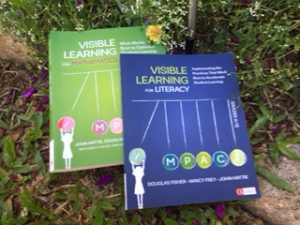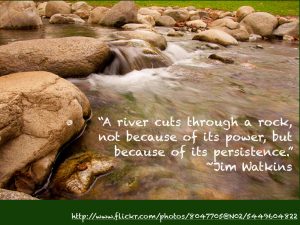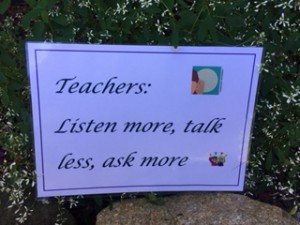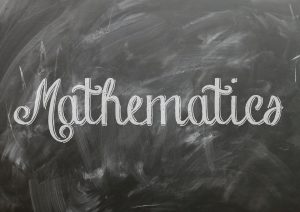 It has been a year since I have visited my site. In that time, I have read and used a number of texts but just haven’t had time to share. My goal this Easter was to re-visit my blog and share a current text. A copy of Visible Learning for Literacy by Hattie, Fisher and Frey was given to all Queensland State School principals at a recent conference. As pre-reading for a professional learning session that I was conducting, I was given a couple of chapters to read and make reference. This pre-reading whetted my appetite and when I found that these authors had also produced a text called Visible Learning for Mathematics, I immediately bought both.
It has been a year since I have visited my site. In that time, I have read and used a number of texts but just haven’t had time to share. My goal this Easter was to re-visit my blog and share a current text. A copy of Visible Learning for Literacy by Hattie, Fisher and Frey was given to all Queensland State School principals at a recent conference. As pre-reading for a professional learning session that I was conducting, I was given a couple of chapters to read and make reference. This pre-reading whetted my appetite and when I found that these authors had also produced a text called Visible Learning for Mathematics, I immediately bought both.

Visible learning in Mathematics
In preparation for another professional learning session, I began reading the mathematics one. It was such an easy read and I read it from front to back. It cleverly combines the effect size work of Hattie and the brilliant pedagogical instruction of Fisher and Frey. Although it is written for mathematics, I can see the ideas transferring to other learning areas.
In the preface to the book, Hattie, Fisher and Frey (2017) write that the denominator of great mathematicians is that they knew how to struggle. Students need to be persistent, enjoy the struggle, and continue to try. As I reflect on my own mathematics education, it is interesting that although I never received brilliant grades, I always enjoyed the challenge of mathematics (and still do to this day). I especially love seeing how other people (including students and my own children) solve problems and have learnt so much by engaging in rich and rigorous discussion about these different techniques. As a teacher, this discussion has transferred to effective mathematics pedagogy and how to enhance mathematics engagement for students.
As I reflect on my own mathematics education, it is interesting that although I never received brilliant grades, I always enjoyed the challenge of mathematics (and still do to this day). I especially love seeing how other people (including students and my own children) solve problems and have learnt so much by engaging in rich and rigorous discussion about these different techniques. As a teacher, this discussion has transferred to effective mathematics pedagogy and how to enhance mathematics engagement for students.
The authors mention four things that make mathematics teaching more powerful: appropriately challenging learning intentions and success criteria; learning that is embedded in discourse and collaboration; students doing more of the thinking and talking than their teacher and; students owning their learning. Hattie adds that greater than an effect size of 0.4 allows students to learn at an appropriate rate. The effect size for classroom discussion is 0.82. Students should be invited to talk in collaborative groups, working to solve complex and rich tasks.
Hattie adds that greater than an effect size of 0.4 allows students to learn at an appropriate rate. The effect size for classroom discussion is 0.82. Students should be invited to talk in collaborative groups, working to solve complex and rich tasks.
Why am I taking the time to share my insights? People who understand mathematics have a higher quality of life. Our moral imperative is every student succeeding. Therefore, to be successful, students must receive high quality instruction (Boaler, 2015).
 There are seven chapters in this book and over the next series of blogs, I will share my insights under the following chapters.
There are seven chapters in this book and over the next series of blogs, I will share my insights under the following chapters.
Chapter 1: Making learning visible in mathematics.
Chapter 2: Teacher clarity.
Chapter 3: Mathematical tasks and talk that guides learning.
Chapters 4-6: The three phases of learning, surface, deep and transfer, one chapter for each phase.
Chapter 7: Assessment, feedback and meeting the needs of all learners.

Hi Ann….thank you. I really enjoyed this post and look forward to hearing more. And, I’m going to hunt down Bec’s copies 🙂
Julia
Thanks Julia. Totally recommend these texts. I also have the literacy text but my penchant for maths won this time.
Thanks Ann, As a teacher and now instructional leader I have always loved the balance of teaching and leading in both literacy and numeracy. Loved hearing Dr Doug Fisher speak at the Middle Leaders QASSP conference this year. Can’t wait to read the Maths text as well.
Thanks Rosemaree. I would have loved to have heard Doug speak again. I found him and Nancy to be very inspirational when I had the privilege of hearing them a few years ago.